| Composite Propeller | Safety | Hobbies| Site Map
The Autogyro does not stall but..... instead
may have another deadly behavior if not properly built!
Jukka Tervamäki, November 2008

Preface
This
story should have been published a decade ago when I originally
designed my web-site but I wanted to avoid any bad
feelings, debate and negative feedback from the gyro community.
At the time Bensen and Ken Brock influence was still very strong
in all matters concerning gyro safety and differing opinions were often
suppressed. Now times have changed and more open discussions have
taken place. And we now have the ASTM gyro standards in US and similar rules are emerging in the European Union!
Over 40 Years of Fatal Gyro Accidents!
Igor
Bensen built his first gyrogliders and gyrocopters in 1950s and soon
started marketing them in earnest. The design was so
simple and easy to build that numerous enthusiasts around the world got
exited and started to build and experiment with the gyros without full
understanding of rotorcraft design, aerodynamics and control
principles. I was one of those enthusiasts, ordered the gyroglider
drawings and built my first machine in 1957.
As the number of machines increased accidents started to happen. At the end of the sixties it was obvious that a certain type of fatal accident was far too common. So discussion, debate and wild explanations started to thrive on the possible cause of these accidents. Bensen always faulted the pilot or bad workmanship, never the basic design.
As the number of machines increased accidents started to happen. At the end of the sixties it was obvious that a certain type of fatal accident was far too common. So discussion, debate and wild explanations started to thrive on the possible cause of these accidents. Bensen always faulted the pilot or bad workmanship, never the basic design.
"Zero-G, porpoising, PIO (Pilot Induced Oscillation)" or what?
In
1969 the first such fatal gyro accident happened in Pori, Finland, a
city on the west
coast of Finland. The machine was a standard Bensen B-8m. I was
appointed as the chairman of the accident investigation committee.
We soon realized that the accident was similar to many accidents
which were common in the US and elsewhere. This was referred to as
"porpoising" or zero-G in the PRA magazine, at the time controlled by
Igor
Bensen, designer of the B-8m gyro and originator of the whole
gyro movement. The cause of the accidents was always considered
as pilot error, lack of training, etc. The accidents
continued to happen, often to pilots having a lot of fixed wing time.
The accident type or cause was later renamed as PIO, Pilot
Induced Oscillation, reminding us again that the cause was the
pilot, not the machine. Typically, the machine was first seen
"porpoising" which increased to a point where the rotor had a negative
angle of attack. At this point the pilot lost control of the
machine and it started tumbling. Rotor rpm slowed down, the
blades hit the tail and a terrible crash resulted. This short
description is exactly what happened in Pori causing the death of
a pilot having 1000 hrs of fixed wing time. You can view the Pori accident description in this link but the notation is in Finnish only.
At about the same time another similar accident happened in England to a Wallis autogyro during the famous Farnborough Air Show. The pilot was a very experienced test pilot. I was in Farnborough at the time but did not actually see the accident happen. However, pictures of the accident were published in newspapers and one can see from the picture sequence below that the rotor had hit the vertical tail and the machine is tumbling down to a final crash.
At about the same time another similar accident happened in England to a Wallis autogyro during the famous Farnborough Air Show. The pilot was a very experienced test pilot. I was in Farnborough at the time but did not actually see the accident happen. However, pictures of the accident were published in newspapers and one can see from the picture sequence below that the rotor had hit the vertical tail and the machine is tumbling down to a final crash.
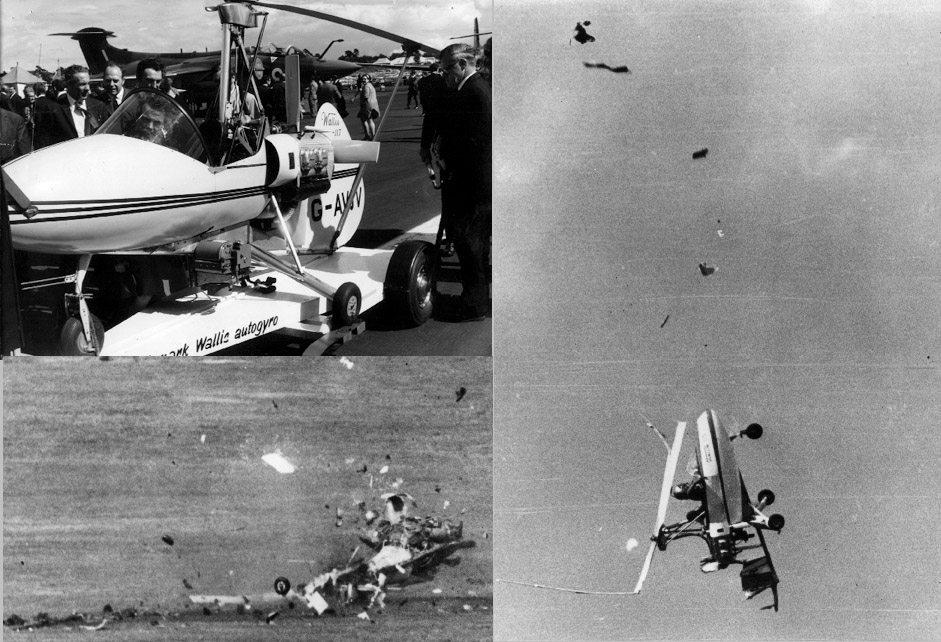
Testing the necessity of a horizontal stabilizer
At the time of these accidents I was flying the ATE-3 gyro,
a machine I had built with Aulis Eerola. We had a horizontal
stabilizer installed in the
machine right from the beginning but decided to test it without one and
with a larger V-tail in addition. The machine was flyable in all
the three configurations but proved to be sensitive to
fly without a horizontal stabilizer. The longitudinal
stability of the machine with the large V-tail was the best but the
lateral
stability left something to be desired. So we returned to the first configuration with horizontal and vertical stabilizers.
I wrote an article of this testing in Sport Aviation in 1971 which was immediately reprinted in the WOT (Wings of Tomorrow). I recommended to install a horizontal stabilizer on all gyros. I received many enthusiastic letters (example1 and example2) but the influence of this article was very minor and short lived. However, I was not completely alone, some months later a similar opinion appeared in September 1971 issue of Helicopter World magazine.
As I expected Bensen did not like my article. When I visited the EAA Fly-In in Oshkosh 1974 he neither wanted to talk with me or take a look at my 8 mm movie of the JT-5 gyro in the air. Regrettably, the end of the friendship. Brock, Wallis and many others did not agree either, not even 30 years later after many, many similar accidents.
The accidents in Finland and our testing of ATE-3 gyro certainly influenced my next design, the JT-5 autogyro, which was on my drawing board in 1969. A big horizontal stabilizer was installed. The first flight was in 1973 and the machine proved to be rock solid stable up to the maximum speed of 100 mph.
I wrote an article of this testing in Sport Aviation in 1971 which was immediately reprinted in the WOT (Wings of Tomorrow). I recommended to install a horizontal stabilizer on all gyros. I received many enthusiastic letters (example1 and example2) but the influence of this article was very minor and short lived. However, I was not completely alone, some months later a similar opinion appeared in September 1971 issue of Helicopter World magazine.
As I expected Bensen did not like my article. When I visited the EAA Fly-In in Oshkosh 1974 he neither wanted to talk with me or take a look at my 8 mm movie of the JT-5 gyro in the air. Regrettably, the end of the friendship. Brock, Wallis and many others did not agree either, not even 30 years later after many, many similar accidents.
The accidents in Finland and our testing of ATE-3 gyro certainly influenced my next design, the JT-5 autogyro, which was on my drawing board in 1969. A big horizontal stabilizer was installed. The first flight was in 1973 and the machine proved to be rock solid stable up to the maximum speed of 100 mph.
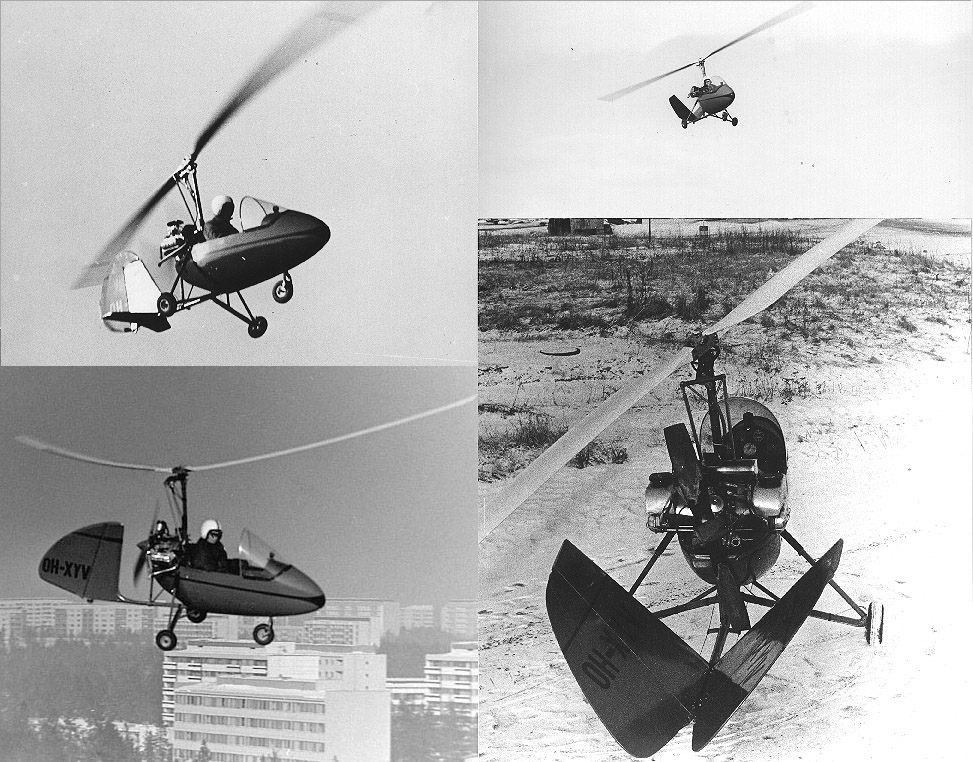
A large horizontal stabilizer for the JT-5 gyro
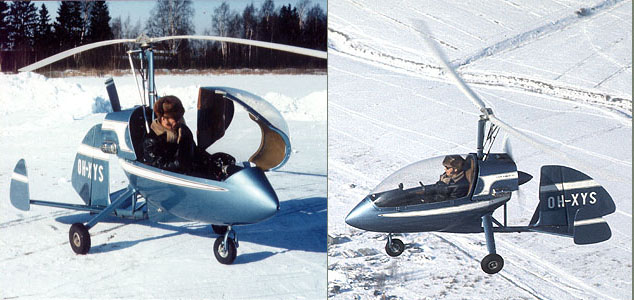
1989 yet another zero-g accident in Finland!
I sold my JT-5 gyro 1974 to Vittorio Magni in Italy who eventually started to build similar designs
having a JT-5 type rotor and good size horizontal stabilizer. In
the following years I concentrated in motorgliders and my next design, the JT-6.
For many years the gyro movement was in the background of my activities,
until.........1989 yet another fatal gyro accident happened in Finland.
Again the machine was a Bensen B-8m copy, a Ken Brock KB-3. The pilot was a very experienced fixed wing pilot. You can read the complete accident report in this link.
Again the machine was a Bensen B-8m copy, a Ken Brock KB-3. The pilot was a very experienced fixed wing pilot. You can read the complete accident report in this link.
My letters to FAA and EAA.
At this point I decided to write letters to FAA and to Jack Cox in EAA
to get a thorough investigation made of these accidents during the past
decades and to get something done on the matter. I got a polite
answer from FAA but the message was more or less like.... "We have no regulations for this
case. Don t worry, just let them fly and die."
Jack Cox from EAA did not answer at all. Probably he sent the letter to Bensen and Brock for comments and...... thats it.
What I proposed was an accident investigation program consisting of complete statistics of gyro accidents starting from 1960 and a test flight program of gyros with and without a horizontal stabilizer.
However, it proved to be impossible to influence the safety matters of gyros from such a tiny country as Finland (population 5 million), which many Americans apparently considered to be behind the iron curtain. During the following years I sent copies of these letters to individuals who had written about the gyro accidents in the press. I never got a comment.
Jack Cox from EAA did not answer at all. Probably he sent the letter to Bensen and Brock for comments and...... thats it.
What I proposed was an accident investigation program consisting of complete statistics of gyro accidents starting from 1960 and a test flight program of gyros with and without a horizontal stabilizer.
However, it proved to be impossible to influence the safety matters of gyros from such a tiny country as Finland (population 5 million), which many Americans apparently considered to be behind the iron curtain. During the following years I sent copies of these letters to individuals who had written about the gyro accidents in the press. I never got a comment.
NTSB statistics
I
don't know if my letter campaign had any influence at all but it so
happened that 3 years later the NTSB finally published
the gyro accident statistics (which I had proposed in my letters)
including both experimental and type certificated gyroplanes. The NTSB made
their own conclusions and afterwards various opinion leaders expressed their views in
gyro magazines and papers. The opinions heavily depended on the
background of the writer. In general, as before, pilots were considered guilty, not the bad designs.
The accident descriptions in the NTSB paper are quite short and witnesses often were not experts to describe what they saw. In addition the NTSB paper did not mention if a horizontal stabilizer was installed in the machines or not. My own interpretation of the statistics can be seen in the graph below. By my count, more than 50 fatal zero-G accidents happened in the 10 years time, how many there have been from 1960 to 2000?
I often wondered how this is possible in the US which has such stringent product liability laws. You only need one nasty lawyer to rake up all this accident history and start very unpleasant actions. But perhaps this was the gyro community voluntary effort to limit earths population explosion.
I am encouraged to be informed that the "Magni gyros have an enviable safety record". This is very good news to me– the Magni gyros are an evolution of the JT-5 design and use a very effective horizontal stabilizer!
The accident descriptions in the NTSB paper are quite short and witnesses often were not experts to describe what they saw. In addition the NTSB paper did not mention if a horizontal stabilizer was installed in the machines or not. My own interpretation of the statistics can be seen in the graph below. By my count, more than 50 fatal zero-G accidents happened in the 10 years time, how many there have been from 1960 to 2000?
I often wondered how this is possible in the US which has such stringent product liability laws. You only need one nasty lawyer to rake up all this accident history and start very unpleasant actions. But perhaps this was the gyro community voluntary effort to limit earths population explosion.
I am encouraged to be informed that the "Magni gyros have an enviable safety record". This is very good news to me– the Magni gyros are an evolution of the JT-5 design and use a very effective horizontal stabilizer!
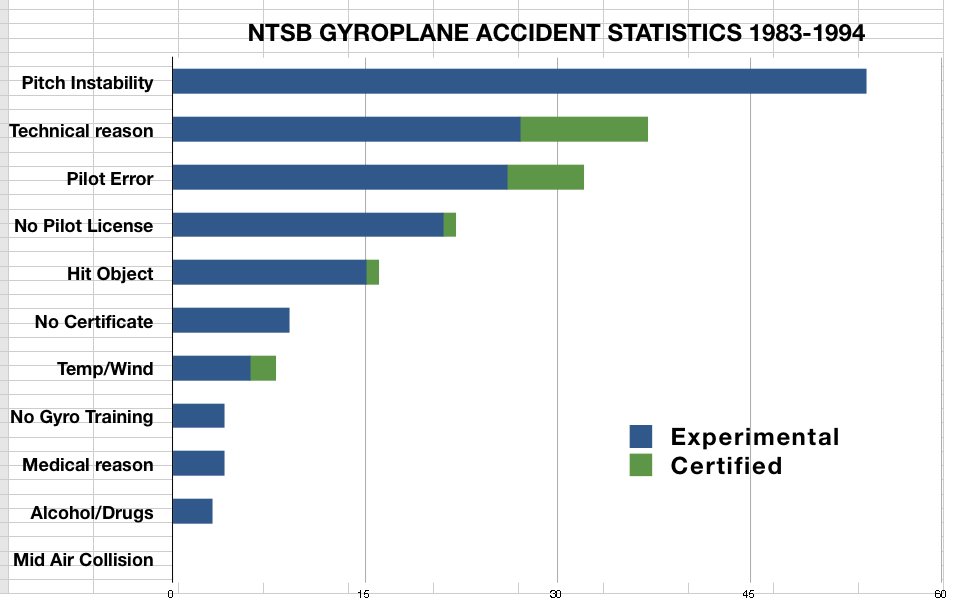
A New Millennium and people who care!
In 2003 an autogyro symposium arranged by professor Bruce Charnov was held at Hofstra University in New York.
Among other influential people in the gyro community I met with my old
friend Vittorio Magni and Greg Gremminger, the ASTM gyroplane
subcommittee chairman and the USA Magni dealer. I soon realized that
there finally were persistent people who really had the same goal as
myself, to improve gyro safety and stop
the maddening crash record of experimental gyros. And Greg had more
persistence, power and prestige than me.
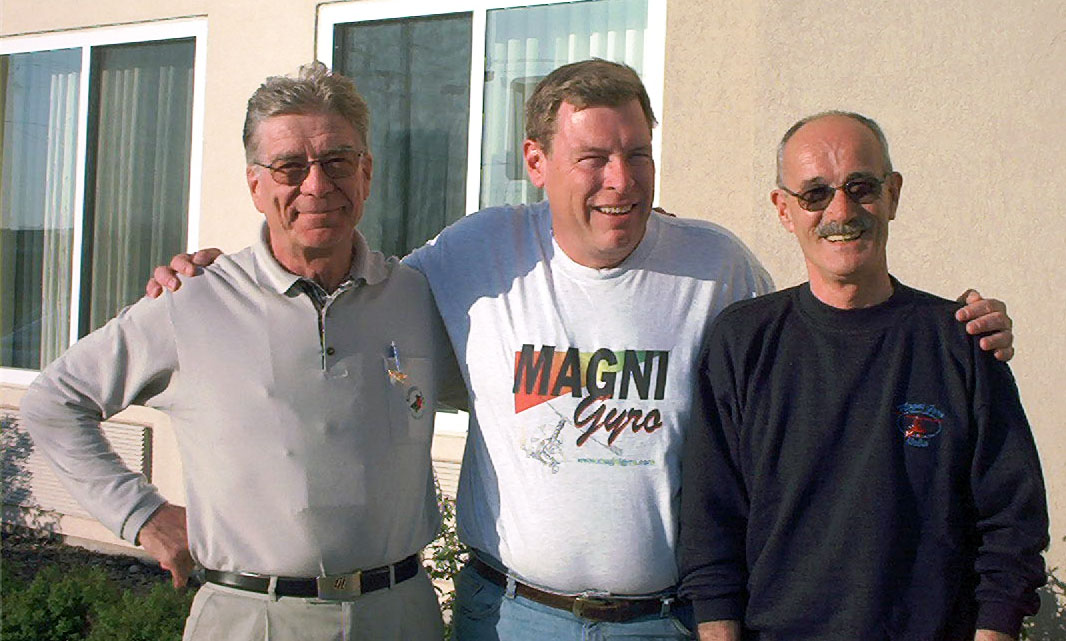
Me, Greg and Vittorio in New York
Pitch Instability!
In 2002, at the request of the US FAA, Greg and others, collected new accident statistics and gave the zero-G accidents a new, proper name: PITCH INSTABILITY! No more were the solely pilots to blame for the crashes. Defective designs, especially machines that had no horizontal stabilizers were found to be a major contributing cause of instability accidents!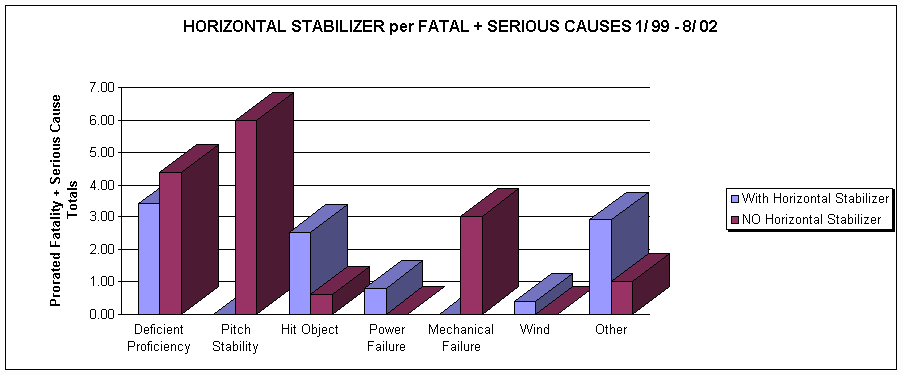
ASTM standard for gyroplanes.
In
the US, the FAA initiated the development of new ASTM standards for
light sport aircraft. A new ASTM standard for gyroplanes was developed
according to a strict “consensus” process by numbers of
influential people in the gyroplane community.
Due to my encounter with Greg at Hofstra University I got involved in the gyro standards balloting. The final result, the ASTM standards for gyroplanes, by raising awareness and knowledge and providing objective criteria by which to determine longitudinal stability of a gyro, is hoped to bring safety improvement into the gyroplane kit industry.
Due to my encounter with Greg at Hofstra University I got involved in the gyro standards balloting. The final result, the ASTM standards for gyroplanes, by raising awareness and knowledge and providing objective criteria by which to determine longitudinal stability of a gyro, is hoped to bring safety improvement into the gyroplane kit industry.
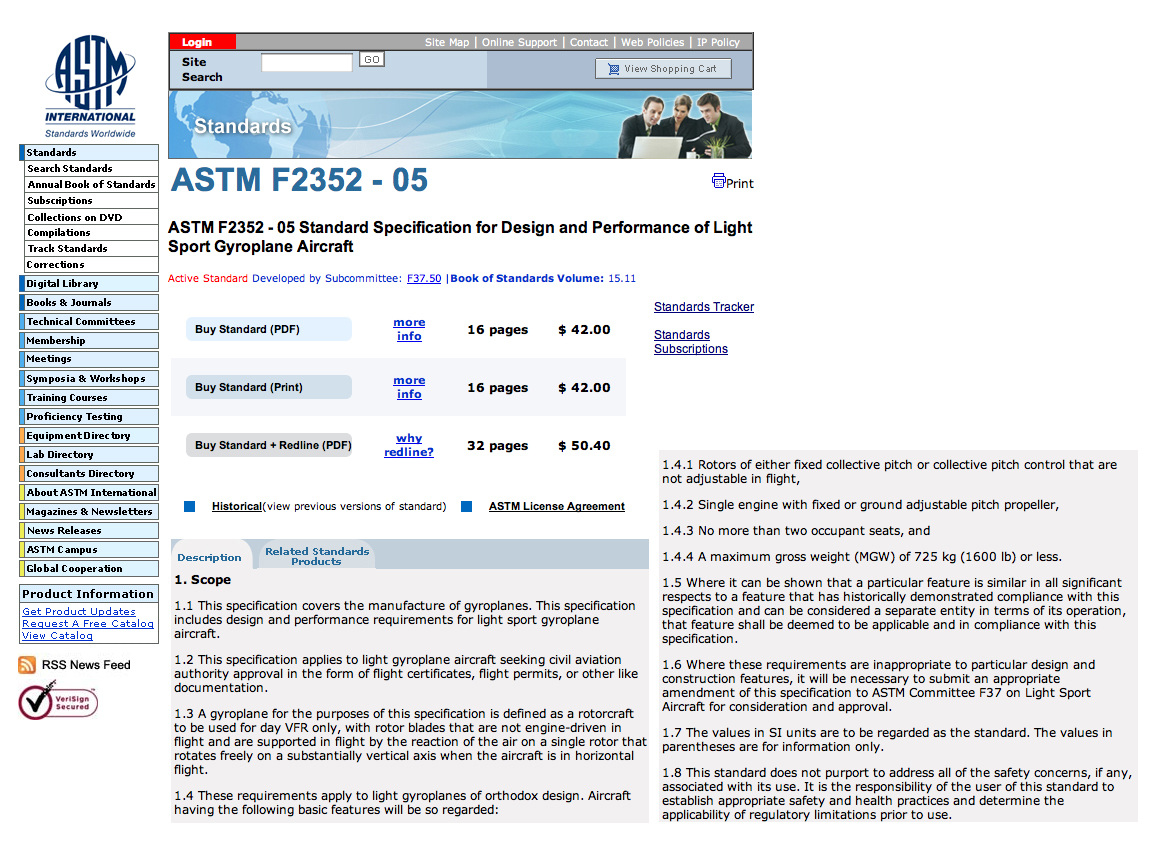
My own Accidents and Incidents summary
I
am lucky I avoided the pitch instability issue early in my gyroplane
experiments. However, I had my share of incidents and accidents, some
of them very serious.
A few years ago an autogyro stability analysis appeared in England by Dr Stewart Houston, University of Glasgow
. In his analysis of the Magni M16 gyro he came to the conclusion that
only the vertical location of centre of gravity with respect to
propeller thrust line affects the gyro stability. This conclusion
has led to a thrust line psychosis in US resulting in some strange looking gyro designs. A caption of the Dr Houston analysis is below:
”The result of this investigation was that pod or tailplane aerodynamics have a very limited effect on longitudinal dynamics. This can be understood considering the relatively small size of these surfaces and the low speed at which the aircraft operates, it is only at the higher speed end of the range that these surfaces have any significant effect. Other parameters such as mast height (i.e. the height of the rotor head above the c.g.) were also considered but theses tended to have more influence on static stability (i.e. trim) than dynamics stability. The only significant configurational effect observed was that of vertical location of centre of gravity with respect to propeller thrust line.
Effect on Longitudinal Stability of Vertical C.G. Position with Respect to Propeller Thrust Line
Measurement of the actual VPM M16 aircraft indicates that the centre of gravity lies just over 1in below the propeller hub. For the purposes of this study, thrust line positions from this point were examined. Table 1 shows the variation in the longitudinal and rotorspeed modes for two configurations of the VPM M16 autogyro with the propeller thrust line 3in above annd 3in below the c.g.. It can be seen that the phugoid oscillation is the most sensitive to the variation in vertical position of the centre- of-gravity relative to the propeller thrust line. In fact if the propeller thrust line is sufficiently far above the centre of gravity then the phugoid motion becomes unstable.”
There is a significant error in the initial value of the CG location in Dr Houston calculations. The CG location of the M16 is about 10 inches below propeller thrust line, not one inch as he mentions. In spite of this 10 fold difference the M16 has been found stable in test flights performed by professional test pilots.
Another oddity in Houston report is that he mentions three fatal gyro accidents in Britain involving a Cricket Mk IV, a RAF 2000 and a Bensen but does not mention the configuration of these aircraft. The main issue is: Did these aircraft have a decent horizontal stabilizer at the time of accidents. So far I know the answer is NO.
In Finland we are presently flying a Magni M24 Orion gyro, which has the same rotor and tailplane as the M16. The vertical location of the Orion CG is about 13 inches below the propeller thrust line when fully loaded.
During the 2010 summer flying season we have flown 160 hours with the M24. This includes pilot training of 6 student pilots 3 of which have completed the training so far (15.9.2010). Two student pilots started training with no other pilot training earlier at all.
The discrepancy of the Houston report conclusions and our own experience with the JT-5 and Magni M24 gyros made me curious of what is this thrust line psychosis all about? Is it really so that a decent tailplane in an autogyro has no significant effect on the autogyro stability?
My own mathematical skills today are far inadequate and outdated but I was lucky to be able to contact Professor Emeritus Seppo Laine who got interested enough in the autogyro stability issue to perform new calculations of what kind of an effect the size of the horizontal stabilizer has on the M16 autogyro stability. Since we have no measured data of our own to do the calculations Prof Laine had to use the Houston report values and assumptions for his analysis.
The analysis has been published in the Helsinki University of Technology series AALTO-AM-18 as a pdf file.
The main conclusion of this analysis is that the M16 needs a horizontal stabilizer to be stable. Further, the stabilizer in M16 is about the right size and distance from CG at the speed (63 mph) the calculations were made. According to the calculations the stabilizer could be up to 20% larger.
My own personal conclusion is that all autogyros must have a decent horizontal stabilizer and this is the main issue in preventing dangerous PIO or Pitch Instability accidents.
Many thanks to Professor Laine for his work. If you have any questions, please, use email:
seppok.laine(at)elisanet.fi
Comments:
1) This is all very interesting and enlightening. I do think the Houston reports have done damage to the evolution of safer gyroplanes by dismissing the value of a HS and concentrating on prop thrustline offset.
Please thank Professor Laine for his work on this. As I understand it, this gives credibility to our arguments that the HS is what provides such stability to the Magni.
2)
”The result of this investigation was that pod or tailplane aerodynamics have a very limited effect on longitudinal dynamics. This can be understood considering the relatively small size of these surfaces and the low speed at which the aircraft operates, it is only at the higher speed end of the range that these surfaces have any significant effect. Other parameters such as mast height (i.e. the height of the rotor head above the c.g.) were also considered but theses tended to have more influence on static stability (i.e. trim) than dynamics stability. The only significant configurational effect observed was that of vertical location of centre of gravity with respect to propeller thrust line.
Effect on Longitudinal Stability of Vertical C.G. Position with Respect to Propeller Thrust Line
Measurement of the actual VPM M16 aircraft indicates that the centre of gravity lies just over 1in below the propeller hub. For the purposes of this study, thrust line positions from this point were examined. Table 1 shows the variation in the longitudinal and rotorspeed modes for two configurations of the VPM M16 autogyro with the propeller thrust line 3in above annd 3in below the c.g.. It can be seen that the phugoid oscillation is the most sensitive to the variation in vertical position of the centre- of-gravity relative to the propeller thrust line. In fact if the propeller thrust line is sufficiently far above the centre of gravity then the phugoid motion becomes unstable.”
There is a significant error in the initial value of the CG location in Dr Houston calculations. The CG location of the M16 is about 10 inches below propeller thrust line, not one inch as he mentions. In spite of this 10 fold difference the M16 has been found stable in test flights performed by professional test pilots.
Another oddity in Houston report is that he mentions three fatal gyro accidents in Britain involving a Cricket Mk IV, a RAF 2000 and a Bensen but does not mention the configuration of these aircraft. The main issue is: Did these aircraft have a decent horizontal stabilizer at the time of accidents. So far I know the answer is NO.
In Finland we are presently flying a Magni M24 Orion gyro, which has the same rotor and tailplane as the M16. The vertical location of the Orion CG is about 13 inches below the propeller thrust line when fully loaded.
During the 2010 summer flying season we have flown 160 hours with the M24. This includes pilot training of 6 student pilots 3 of which have completed the training so far (15.9.2010). Two student pilots started training with no other pilot training earlier at all.
The discrepancy of the Houston report conclusions and our own experience with the JT-5 and Magni M24 gyros made me curious of what is this thrust line psychosis all about? Is it really so that a decent tailplane in an autogyro has no significant effect on the autogyro stability?
My own mathematical skills today are far inadequate and outdated but I was lucky to be able to contact Professor Emeritus Seppo Laine who got interested enough in the autogyro stability issue to perform new calculations of what kind of an effect the size of the horizontal stabilizer has on the M16 autogyro stability. Since we have no measured data of our own to do the calculations Prof Laine had to use the Houston report values and assumptions for his analysis.
The analysis has been published in the Helsinki University of Technology series AALTO-AM-18 as a pdf file.
The main conclusion of this analysis is that the M16 needs a horizontal stabilizer to be stable. Further, the stabilizer in M16 is about the right size and distance from CG at the speed (63 mph) the calculations were made. According to the calculations the stabilizer could be up to 20% larger.
My own personal conclusion is that all autogyros must have a decent horizontal stabilizer and this is the main issue in preventing dangerous PIO or Pitch Instability accidents.
Many thanks to Professor Laine for his work. If you have any questions, please, use email:
seppok.laine(at)elisanet.fi
Comments:
1) This is all very interesting and enlightening. I do think the Houston reports have done damage to the evolution of safer gyroplanes by dismissing the value of a HS and concentrating on prop thrustline offset.
Please thank Professor Laine for his work on this. As I understand it, this gives credibility to our arguments that the HS is what provides such stability to the Magni.
2)
